Special Plastic Adsorbs Massive Quantities of CO2; Could Help Transition to Green Energy
| Marc Maligalig | | Aug 11, 2014 02:05 AM EDT |
(Photo : Wikimedia Commons) Smoke stacks
Scientists have developed a special plastic that absorbs carbon dioxide in a process that yields clean fuel.
A report published by the American Chemical Society said a technology called the integrated gasification combined cycle, or IGCC, produces hydrogen gas and carbon dioxide, which must be filtered out.
Like Us on Facebook
The "plastic sponge," which is a "microporous organic polymer" that cleans out the carbon dioxide works at optimal efficiency at the high pressures present in the IGCC method.
The adsorbent grows slightly larger, like a kitchen sponge absorbing water, as the plastic lets carbon dioxide inside the microscopic spaces between its molecules.
When the pressure is relieved, the plastic shrinks back to its original size. It then emits carbon dioxide, which can be collected and processed into other carbon-based compounds.
"The key point is that this polymer is stable, it's cheap, and it adsorbs CO2 extremely well. It's geared toward function in a real-world environment," said Andrew Cooper, Ph.D.
"In a future landscape where fuel-cell technology is used, this adsorbent could work toward zero-emission technology."
Carbon dioxide adsorbents are often used to extract the greenhouse gases from smokestacks at power plants that burn coal or natural gas.
Cooper and his partners aim to use the adsorbent, a microporous organic polymer, to minimize air pollution by sucking the carbon dioxide straight from the air, said Science Daily.
The emerging integrated gasification combined cycle, a technology that can turn petrol and other carbon based fuels into hydrogen gas, is expected to use the new material.
The hydrogen produced could be used to generate electricity and power in cars running on fuel-cells since it produces close to no pollution.
The process aims increase interest in the hydrogen economy and transition the public to hydrogen fuel while retaining the current fossil-fuel infrastructures.
The report on the adsorbent polymer was one of the 12,000 reports at the 248th National Meeting and Exposition of the American Chemical Society, which is the largest global scientific society, held from Aug. 10 to 14.
TagsPollution, carbon dioxide, green house gasses, Plastic, global warming, Chemistry, Science, scientific research
©2015 Chinatopix All rights reserved. Do not reproduce without permission
EDITOR'S PICKS
-

Did the Trump administration just announce plans for a trade war with ‘hostile’ China and Russia?
-

US Senate passes Taiwan travel bill slammed by China
-

As Yan Sihong’s family grieves, here are other Chinese students who went missing abroad. Some have never been found
-

Beijing blasts Western critics who ‘smear China’ with the term sharp power
-

China Envoy Seeks to Defuse Tensions With U.S. as a Trade War Brews
-

Singapore's Deputy PM Provides Bitcoin Vote of Confidence Amid China's Blanket Bans
-

China warns investors over risks in overseas virtual currency trading
-

Chinese government most trustworthy: survey
-

Kashima Antlers On Course For Back-To-Back Titles
MOST POPULAR
LATEST NEWS
Zhou Yongkang: China's Former Security Chief Sentenced to Life in Prison

China's former Chief of the Ministry of Public Security, Zhou Yongkang, has been given a life sentence after he was found guilty of abusing his office, bribery and deliberately ... Full Article
TRENDING STORY

China Pork Prices Expected to Stabilize As The Supplies Recover

Elephone P9000 Smartphone is now on Sale on Amazon India

There's a Big Chance Cliffhangers Won't Still Be Resolved When Grey's Anatomy Season 13 Returns

Supreme Court Ruled on Samsung vs Apple Dispute for Patent Infringement

Microsoft Surface Pro 5 Rumors and Release Date: What is the Latest?










